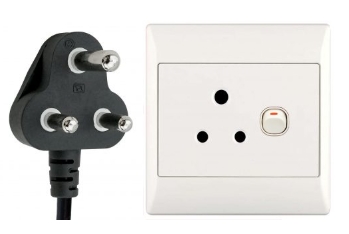Power plug & outlet Type D
Date:2022-06-27 Click:2438 Source:Caron
TYPE D
Type D is almost exclusively used in India and Nepal.

India has standardized on a plug which was originally defined in British Standard 546 (the standard in Great Britain before 1947). This 5 amp plug has three round prongs that form a triangle. The central earth pin is 20.6 mm long and has a diameter of 7.1 mm. The 5.1 mm line and neutral pins are 14.9 mm long, on centres spaced 19.1 mm apart. The centre-to-centre distance between the grounding pin and the middle of the imaginary line connecting the two power pins is 22.2 mm. Type M, which has larger pins and is rated at 15 amps, is used alongside type D for larger appliances in India, Nepal and Pakistan. Some sockets can take both type M and type D plugs.
Incidentally, there is an unintended compatibility between type D sockets and various European plugs. Although the centres of the prongs of a Europlug (type C) are closer together (17.5-18.6 mm vs 19.1 mm) than those of a type D plug, a Europlug often fits into a type D outlet without much effort, largely thanks to the elasticity of its pins. However, the plug cannot be fully inserted into a D receptacle, because the prongs are inelastic at the base of the plug and they are longer than the pins of type D plugs (19 mm vs 14.9 mm). This is the reason why type C plugs do not always make proper contact and may cause the socket to spark, which, in some cases, might result in a short-circuit.
Whereas type C plugs and type D sockets could be considered an unsafe, but ‘relatively workable’ combination, using E/F plugs with D outlets is downright dangerous. The centres of the pins of type E & F plugs are slightly closer together (19 mm vs 19.1 mm) than those of type D, but unlike Europlugs (type C), they do not have flexible prongs. This means they literally have to be forced into the receptacle. Obviously, this kind of improper use poses an enormous safety hazard for a number of reasons. Firstly – unlike type C – E & F plugs are supposed to be grounded, but when they are used with type D outlets, this won’t be the case. So, be prepared for a sparking receptacle and a regularly tripping circuit breaker. Moreover, type E and F plugs cannot be fully inserted into a D socket, because the pins are longer than the pins of type D plugs (19 mm vs 14.9 mm). This means that 4.1 mm of the pins of plug types E & F will still be exposed when plugged in and if you were to touch the live prong, you most certainly will get an electric shock. This risk does not exist with type C plugs, since their pins are coated in insulation.
Although type D is now almost exclusively used in India and Nepal, it can still occasionally be found in hotels in the UK. It should be noted that tourists should not attempt to connect anything to a BS 546 round-pin outlet found in the UK as it is likely to be on a circuit that has a special purpose: e.g. for providing direct current (DC) or for plugging in lamps that are controlled by a light switch or a dimmer.
Type D plugs are among the most dangerous ones in the world: the prongs are not insulated (i.e. the pin shanks do not have a black covering towards the plug body like type C, G, I, L or N plugs), which means that if a type D plug is pulled halfway out, its prongs are still connected to the socket! Little children run the risk of electrocuting themselves when pulling such a plug out and putting their fingers around it. Type D outlets are not recessed into the wall, so they do not provide any protection from touching the live pins either.

